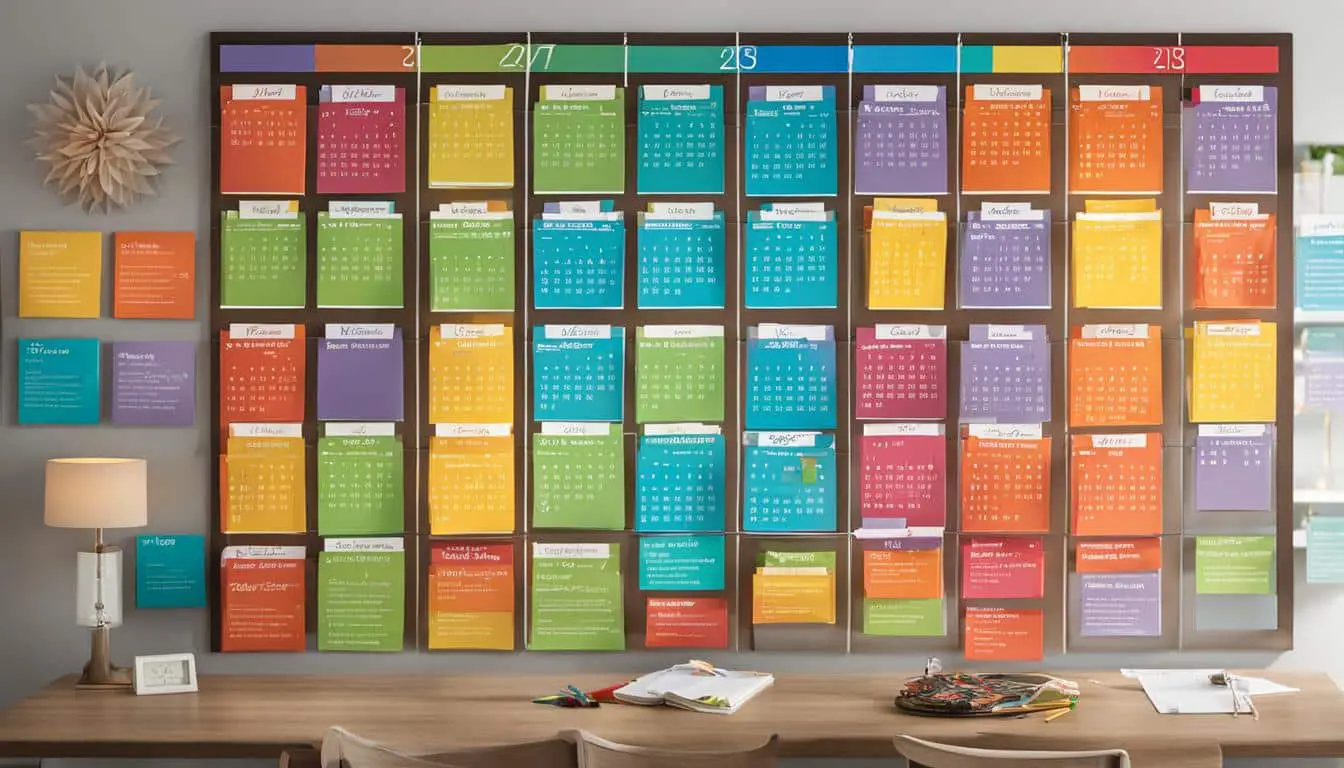
Organizing Family Schedules: A Step-by-Step Guide
The demands of juggling family and work responsibilities can often leave families feeling overwhelmed and stressed. However, with the right strategies in place, it is possible to organize family schedules efficiently and create a harmonious balance. In this step-by-step guide, I will explore effective techniques for family schedule management, including time management strategies, family calendar organization, and optimizing productivity for the entire family.
Key Takeaways:
- Setting priorities and establishing clear goals is vital for effective family scheduling.
- Creating routines and time blocks can maximize family productivity and create a sense of structure.
- Managing responsibilities and delegating tasks ensures efficient family scheduling.
- Utilizing technology and communication tools can greatly aid in organizing family schedules.
- Organizing family schedules efficiently requires commitment and collaboration.
Setting Priorities and Establishing Goals
To effectively organize family schedules, it is crucial to set priorities and establish clear goals. This initial step lays the foundation for streamlined family planning and efficient family calendar management. One effective way to achieve this is through a weekly family meeting, where all members are encouraged to contribute their ideas and suggestions.
During the meeting, it is important to identify the most important tasks and commitments that require attention. This includes crucial activities such as homework, extracurricular activities, and quality family time. By reviewing the family’s goals, discussing priorities, and determining what activities can be fit into the schedule and what can be dropped, families can create a roadmap for effective family scheduling.
“The secret of getting ahead is getting started.” – Mark Twain
By actively involving everyone in the decision-making process, families can ensure that the schedule reflects the needs and aspirations of each member. This collaborative approach not only promotes a sense of ownership and responsibility but also enhances the overall efficiency of family scheduling.
Benefits of Setting Priorities and Establishing Goals
The process of setting priorities and establishing goals brings several benefits to the family. These include:
- Optimized Time Management: By identifying and prioritizing key activities, families can make better use of their time and avoid overcommitting.
- Increased Productivity: With a clear focus on important tasks, family members can stay organized and accomplish more in less time.
- Better Work-Life Balance: Establishing goals enables families to allocate time for both work and leisure activities, promoting a healthier balance between personal and professional life.
| Priority | Activity | Time Allocation |
|---|---|---|
| 1 | Homework | 2 hours per day |
| 2 | Extracurricular Activities | 3 hours per week |
| 3 | Quality Family Time | 2 hours per day |
The table above provides a visual representation of how priorities can be translated into actionable time allocations. By allocating dedicated time for each activity, families can ensure a well-balanced schedule that caters to their specific needs.
Creating Routines and Time Blocks
Creating routines and time blocks is essential for maximizing family productivity and creating a sense of structure. Research has shown that routines contribute to better sleep habits, improved behavior in children, and increased efficiency in adults. By incorporating regular routines and time blocks into your family’s schedule, you can effectively organize your day and ensure that everyone’s needs are met.
The Benefits of Routines
Establishing routines provides several benefits for the entire family. Routines help reduce decision fatigue, as they eliminate the need to make constant choices about what to do next. They create a predictable environment that promotes a sense of security and stability.
“Routines provide children with a predictable framework and a sense of security, allowing them to thrive.”
Moreover, routines contribute to better time management and family time organization. When everyone knows what to expect and when, you can allocate specific time slots for various activities such as meals, homework, exercise, and relaxation. By sticking to a routine, you can establish a healthy work-life balance and ensure that important tasks are not overlooked.
Implementing Time Blocks
One effective strategy for managing family schedules is to implement time blocks. Time blocks are dedicated periods of time set aside for specific activities. By assigning time blocks to different tasks, you can allocate your time and energy more efficiently.
Here’s an example of how you can utilize time blocks:
| Time Block | Activity |
|---|---|
| Morning | Breakfast and getting ready for the day |
| Mid-Morning | Homework or remote learning |
| Noon | Lunch and free time |
| Afternoon | Extracurricular activities or household chores |
| Evening | Dinner and family time |
| Night | Wind down and bedtime routine |
By breaking down your day into manageable chunks and assigning time blocks, you can create a structured schedule that maximizes productivity and ensures that everyone’s needs are met.
Incorporating routines and time blocks into your family’s schedule is key to
maximizing family productivity
and promoting a balanced lifestyle. By establishing predictable routines and setting aside dedicated time blocks for various activities, you can effectively manage your time, reduce stress, and create more opportunities for quality family time. Stick to the schedule and adjust as needed to maintain a sense of balance and keep your family on track.
Managing Responsibilities and Delegating Tasks
When it comes to efficient family scheduling, managing responsibilities and delegating tasks is crucial. This goes beyond just planning the activities; it involves ensuring that tasks are properly distributed among family members. By assigning chores, setting expectations for completion, and providing incentives, families can optimize their scheduling practices and create a sense of shared responsibility.
“Alone we can do so little; together we can do so much.”
Involving everyone in the process not only lightens the burden on one individual but also fosters a sense of teamwork and cooperation. By sharing responsibilities, family members gain a better understanding of each other’s roles and challenges, which can lead to improved communication and empathy.
Benefits of Managing Responsibilities and Delegating Tasks
There are several benefits to managing responsibilities and delegating tasks:
- Reduces stress and overwhelm for individuals by distributing the workload.
- Teaches children valuable life skills and the importance of contributing to the family unit.
- Fosters a sense of fairness and equity within the family.
- Promotes accountability and follow-through on commitments.
- Allows for better time management and increased productivity.

| Responsibility | Assigned To | Frequency |
|---|---|---|
| Daily chores (e.g., dishes, laundry) | Emma | Every day |
| Grocery shopping | Sam and Sarah | Weekly |
| Meal preparation | John and Emma | Rotating schedule |
| Childcare during work hours | Sarah | Alternate weeks |
| Outdoor maintenance (e.g., gardening, lawn care) | John | Monthly |
By clearly defining responsibilities and establishing a system for task delegation, families can streamline their scheduling processes and create a more harmonious environment for everyone.
Utilizing Technology and Communication Tools
In today’s digital age, technology and communication tools play a pivotal role in efficient family calendar management and family schedule organization. By leveraging these tools, families can streamline communication, enhance coordination, and stay on top of their busy schedules. Let’s explore some of the key tools that can help families optimize their scheduling processes.
Shared Calendars
A shared calendar is a powerful tool that enables family members to coordinate activities and keep track of everyone’s schedules in one centralized location. By utilizing shared calendars, families can avoid scheduling conflicts and stay organized. Popular calendar apps like Google Calendar and Apple Calendar allow users to create individual calendars for each family member and share them with others. This promotes transparency, ensures everyone is aware of each other’s commitments, and enables efficient coordination.
Task Management Apps
Task management apps can be invaluable for family schedule organization. These apps provide a platform for families to create and assign tasks, set deadlines, and track progress. Todoist, Wunderlist, and Trello are popular task management apps that offer features like reminders, priority settings, and task categorization. By using these apps, families can allocate responsibilities, visualize their to-do lists, and foster a sense of accountability.
Messaging Platforms
Effective communication is essential for efficient family schedule management. Messaging platforms such as WhatsApp and Slack provide families with a convenient and instant way to stay connected and share important reminders. Families can create dedicated groups for different purposes, such as school events, extracurricular activities, or meal planning. By utilizing messaging platforms, families can quickly communicate changes or updates to the schedule and ensure everyone is well-informed.
When leveraging technology and communication tools, it’s important to strike a balance between virtual and face-to-face interactions. While these tools are incredibly useful for family schedule organization, maintaining meaningful connections and spending quality time together is equally important. Now let’s take a look at a table that outlines some popular technology and communication tools for efficient family calendar management:
| Tool | Description |
|---|---|
| Google Calendar | A web-based calendar app that allows users to create and share calendars for efficient scheduling. |
| Apple Calendar | A calendar app designed for Apple devices, enabling seamless scheduling and synchronization across multiple devices. |
| Todoist | A task management app that helps families create, assign, and track tasks to stay organized and productive. |
| Wunderlist | A user-friendly task management app that allows families to create and manage tasks with ease. |
| Trello | A collaborative project management tool that enables families to visualize and organize their tasks and schedules. |
| A widely used messaging platform that offers group chats and quick communication for family members. | |
| Slack | A team communication tool that supports real-time messaging, file sharing, and dedicated channels for different topics. |
By harnessing the power of technology and utilizing effective communication tools, families can streamline their scheduling processes, reduce confusion, and strike a harmonious balance between responsibilities and quality time together. Embracing these tools will not only improve family calendar management but also enhance overall family well-being.

Conclusion
Organizing family schedules efficiently is a continuous process that requires commitment and collaboration. By setting priorities and establishing clear goals, families can streamline their planning and create a harmonious balance. Creating routines and time blocks is crucial for maximizing family productivity and ensuring that everyone’s needs are met. By managing responsibilities and delegating tasks, families can optimize their scheduling practices and relieve the burden on one individual.
Utilizing technology and communication tools is essential for efficient family calendar management. By using shared calendars, task management apps, and messaging platforms, families can coordinate activities, share important reminders, and stay connected. These tools streamline communication, reduce confusion, and keep everyone on the same page.
By implementing the strategies outlined in this guide, families can create a well-organized schedule that allows them to enjoy quality time together, reduce stress, and achieve their goals. Organizing family schedules efficiently not only maximizes family productivity but also creates a more efficient and productive family life overall.
FAQ
What is the first step in organizing family schedules?
The first step in organizing family schedules is to set priorities and establish clear goals. This can be done through a weekly family meeting where everyone is encouraged to contribute their ideas and suggestions.
How can creating routines and time blocks help with family scheduling?
Creating routines and time blocks is crucial for maximizing family productivity and creating a sense of structure. By allocating specific time slots for activities such as meals, homework, exercise, and relaxation, families can ensure that everyone’s needs are met while maintaining a sense of balance.
Why is managing responsibilities and delegating tasks important in family scheduling?
Managing responsibilities and delegating tasks ensures that the burden of organizing a family’s schedule is not placed solely on one individual. By involving everyone in the process, families can create a sense of shared responsibility and relieve the pressure on one person.
How can technology and communication tools aid in family scheduling?
Technology tools such as shared calendars, task management apps, and messaging platforms can greatly aid in organizing family schedules. These tools help streamline communication, reduce confusion, and ensure that everyone is on the same page.